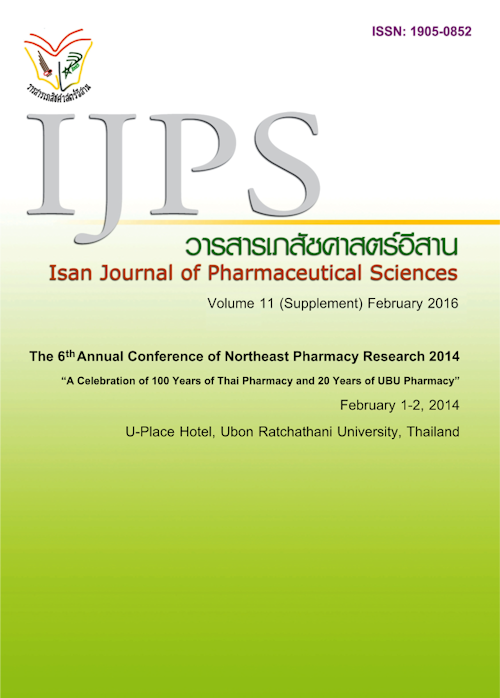Effects of Pseuderanthemum palatiferum ethanolic Leaf Extract on Rat Adipocyte Lipolysis
Main Article Content
Abstract
Introduction: Pseuderanthemum palatiferum (Nees) Radlk. (Phayawanon in Thai) is a medicinal plant in the family of Acanthaceae. The leavs of this plant are widely used as the medicinal herb to treat various diseases, including diabetes in Thailand. This study was aimed to investigate the effects of Pseuderanthemum palatiferum ethanolicleaf extract, (PPE extract) at the concentrations of 10, 25, 50, 100, 250 and 500 µg/mL on adipocyte lipolysis in adipocytes isolated from normal pellet diet (NPD)-fed rats and high fat diet (HFD)-fed rats. Materials and Method: Sixteen male Wistar rats were divided into 2 groups (8 rats per group) and were fed with NPD or HFD for three weeks. The adipocyte suspensions were prepared by the collagenase digestion method. The levels of the adipocyte lipolysis were indicated by the concentration of glycerol in the incubation media after 1 hour-incubation. Results: PPE extract at any concentration tested did not cause any effect on basal lipolysis in adipocytes derived from the NPD-fed rats. However, PPE extract at the concentrations of 25, 50, 100, 250 and 500 µg/mL significantly inhibited isoprenaline (0.1 µM )-induced lipolysis (glycerol concentration were 113.96 ± 3.09, 111.14 ± 10.56, 92.15 ± 3.83, 79.26 ± 8.95 and 79.14± 1.05 µg mL-1/mL packed cell volume (PCV)/hr ( n = 4;p< 0.05), respectively). In adipocytes devised from the HFD-fed rats, PPE extract at all tested concentrations significantly inhibited basal lipolysis, with the glycerol concentrations of42.21 ± 2.31, 38.92 ± 2.85, 40.45 ± 1.45, 36.93 ± 1.56, 35.18 ± 1.90 and 46.90 ± 2.48µg mL-1/mL PCV/hr (n = 3-5;p< 0.05, respectively). Conversely, PPE extract at any concentration tested did not cause any effect on isoprenaline (0.1 µM)-induced lipolysis in adipocyte isolated from HFD-fed rats. Conclusion: The lipolytic inhibitory effect of PPE extract found in this study may partly explain its mechanism of action, involving in the treatment of diabetes and dyslipidemia. However, further investigations are needed to explore the possible target site of its inhibitory action on adipocyte lipolysis.
Article Details
In the case that some parts are used by others The author must Confirm that obtaining permission to use some of the original authors. And must attach evidence That the permission has been included


